Everyone talks about how magical Europe is in spring and fall—the so-called „shoulder seasons.“ You’ll hear phrases like fewer crowds, milder weather, and better prices. And while a lot of that is true, there’s so much that no one tells you until you’re actually standing under an overcast sky, wondering why the museum hours suddenly changed.
After traveling through cities like Dubrovnik, Vienna, and Edinburgh during the off-peak months, I’ve learned the beauty and the frustrations of shoulder-season travel. Here’s what I wish I knew before planning—and what you should consider before booking that dreamy May or October getaway.
1. The Weather Is Wildly Unpredictable
The internet may promise mild, pleasant weather—but I’ve had everything from surprise hailstorms in Austria to blazing sun in Ireland. You need to pack layers (and possibly waterproof shoes), no matter what the forecast says. Shoulder season is less predictable than it looks on Instagram.
Pro tip: Always pack a compact umbrella, a trench coat, and a light sweater—even for southern Europe.
2. Opening Hours Can Be a Mess
Museums, castles, even restaurants often shift to reduced hours without much notice. In Munich, a charming pavillon I’d bookmarked was closed for “winter transition” in early November. Be ready to pivot your plans and always double-check hours on Google and the official websites.
3. You’ll Have Moments of Magic (and Solitude)
Here’s the upside: fewer crowds really can transform the experience. I’ve stood alone inside palaces in Munich and walked through near-empty streets in Dublin at golden hour. It’s peaceful, surreal, and honestly, worth the trade-offs if you’re seeking a more reflective trip.
4. Prices Can Be Lower—But Not Always
Flights and hotels are usually cheaper, but not across the board. Tourist-heavy destinations like Athens or Amsterdam may still charge peak prices for certain attractions or tours. And in smaller cities, the fewer accommodation options might mean paying a premium even in off-season. My advice: Use Google Flights’ date grid and book directly through hotels for shoulder season perks (like free breakfast or room upgrades).
5. Locals Are More Relaxed (and You’ll Feel It)
This might be my favorite part: without peak-season pressure, locals are often more open to conversation, more patient, and more genuine. I’ve had warm chats with café owners, extra time with museum guides, and better service in restaurants during shoulder season than I ever did in July.
Final Thoughts
Shoulder season travel isn’t as effortless as TikTok might make it look, but it is worth it—if you’re prepared. Embrace the unexpected, plan for flexibility, and you might just discover your favorite version of Europe.If you’re a traveler using PTO, shoulder season gives you more value for your time and money—but it requires smart planning. That’s why I always travel with my own set of go-to planning tools.
P.S. My Smart Traveler’s Toolkit includes my seasonal packing list, weather planner, and itinerary template




Schreibe einen Kommentar